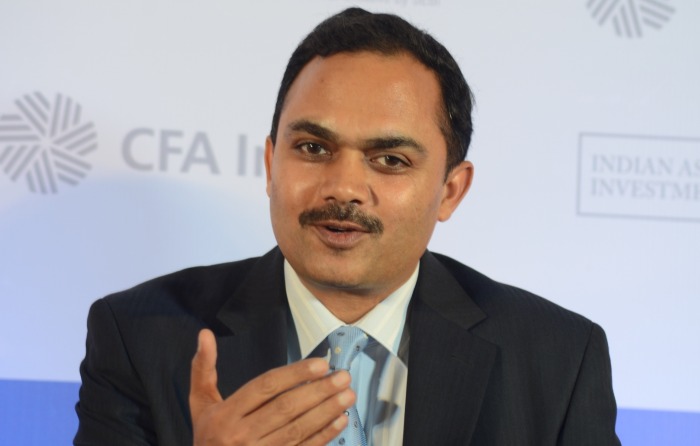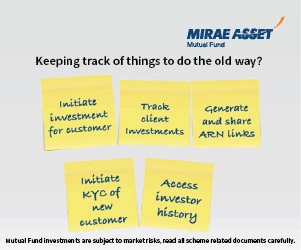An evening with Prashant Jain

Prashant Jain is one of the well respected names in the fund management industry. He is the CIO (Chief Investment Officer) of HDFC mutual fund. Very few can boast of long term track record as he has. He is intelligent, soft spoken, balanced and share good insights.
Some of the IFAs (Independent Financial Advisors) in Chennai had the opportunity to listen to and interact with him for close to 2 hours last week. I was one among them. I want to share few things below based on this meeting. This piece is based on what I know and have been sharing with you, what perspectives Prashant shared with us plus my own understandings and observations on the points discussed. So it’s a mixture or muesli or kitchidi:-)
1) What’s important is to take a broad view for long term. This ensures that we’re not blinded by day to news and events. Media focuses on negative news because it sells. Consistent, day to day growth which increases the earnings do not make interesting read and hence ignored. Even in these tough times, earnings have been growing at 15%.
2) At current levels markets are trading at less than 14 PE (for FY14). This is lesser than long term averages. Though Sensex is at similar level to 2007, when PE was 28, the PE is now 14, implies earnings have doubled in the last 5 tough years. At 15% annualized growth, the Sensex earnings may cross 2000 in next few years. So it would not be surprise if market touches new highs in the years to come.
3) Markets are heavily polarized with some large cap and high quality companies being very expensive and the broader markets being cheap. As interest ratings are peaking, lower rates would be supportive of higher PEs. Earnings growth and higher PEs would lead to good results for investors.
4) I was surprised to know that the land under agriculture in India is higher than that of China. We are self sufficient in food, vegetables, minerals etc. This is one of the few places where one gets sunshine through out the year. Till few centuries back, India contributed to 25% of the world GDP. We’ve been growing despite politicians and corruption. We have more number of entrepreneurs in the world.
5) Every decade after independence, the GDP is growing. Despite volatility in growth rates, it has been in the secular, sustainable, high growth trend. Growth will continue till we get saturated with higher base. For example, in 2001, 3% of our households owned a car. Now it has trebled to 9% of household. It is expected to touch 20% of house holds in 2020. Till 100% of households owns a car (there are countries which have more cars than households), the high growth trajectory can be maintained by an economy. So it looks like we would have good growth rate in the decades to come.
6) When the economy is in such a growth trajectory, it is wiser to own equities. Companies, hence equities, will do well in such economies. GDP growth is followed by earnings growth which is followed by equity valuations. Indians missing out a lot by under owning equity. Mutual funds own 3.4% of the total equity which is down from 7% ten years ago. Public shareholding has come down to 14.2% from 22.7% during the same period. FIIs have always been net buyers (except two years- Pokhran nuclear test & 2008 Lehman crisis) and they are the ones who are benefiting the most by our growth story.
7) Equities are less risky and volatile over long term. Hence it makes sense to invest regularly and also when PE levels are lower. Lump sum investments may be avoided at higher PEs, which is where most investors come and invest. The saving grace is that because of our growth in earnings, even those who invest at higher PEs don’t loose out in the long run, though their returns would be muted. The best option is regular and disciplined investing.
8) The slowing of growth rate is actually good as it reduces inflation which would reduce interest rates which would increase investments which would increase growth and so on. Slowing consumption is necessary to fix the imbalances in the economy and will overtime result in higher and better quality of growth. As always, these things would continue to be cyclical. As we are in the secular long term uptrend, for an investors who invest regularly and for long term, these cycles don’t matter and in fact can even be helpful.
9) Gold has had a strong bull run over a decade and medium to long term outlook for it look weak. North America’s growing strength in hydro carbon and shale gas may stabilize or lower the oil prices in the medium term. A weak gold and oil prices can do wonders to our deficit and economy. Le us hope for the best!
10) In tough times, we tend to think good times never come and in good times, we tend to think it would last forever. Nothing is farther from truth. The truth is things are cyclical and you would do well if you are disciplined in investing and asset allocation. India and its equity markets offer a great scope for building long term wealth. Make use of it to reach your goals and fulfill your aspirations.
Queries
-
What is the benefit of mutual fund STP
Aug 29, 2019
-
How much to invest to meet target amount of Rs 2 Crores
Aug 26, 2019
-
Can I achieve my financial goals with my current mutual fund investments
Aug 24, 2019
-
Can you tell me return of various indices
Aug 19, 2019
-
What would be the post tax return on different investments
Aug 18, 2019
-
Which Principal Mutual Fund scheme will be suitable for my retirement corpus
Aug 16, 2019
-
What is the minimum holding period for availing NCD interest
Aug 4, 2019
Top Performing Mutual Funds
Recommended Reading
Fund News
-
Bandhan Mutual Fund launches Bandhan Silver ETF FOF
Jan 12, 2026 by Advisorkhoj Team
-
Bandhan Mutual Fund launches Bandhan Gold ETF FOF
Jan 12, 2026 by Advisorkhoj Team
-
The Wealth Company Mutual Fund launches The Wealth Company Gold ETF FOF
Jan 9, 2026 by Advisorkhoj Team
-
Mahindra Manulife Mutual Fund launches Mahindra Manulife Innovation Opportunities Fund
Jan 9, 2026 by Advisorkhoj Team
-
Jio BlackRock Mutual Fund launches Jio BlackRock Short Duration Fund
Jan 8, 2026 by Advisorkhoj Team














